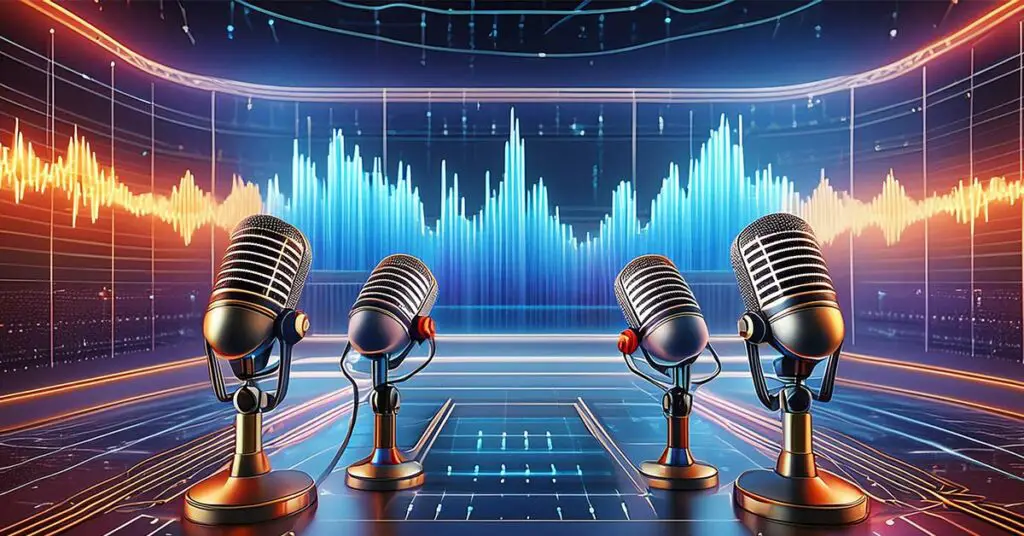In the world of video production, achieving clear and crisp audio can be just as challenging as nailing the perfect visuals. Whether you’re shooting a big-budget feature film or a corporate video, dialogue issues like ambient noise, poor recording conditions, or actor flubs can severely compromise the final product’s quality.
This is where Automated Dialogue Replacement (ADR), also known as dubbing, comes into play. ADR techniques allow filmmakers to re-record and replace audio in post-production, ensuring that the dialogue is pristine and aligns seamlessly with the on-screen action. In this comprehensive guide, we’ll delve deep into the world of ADR, exploring its benefits, various techniques, workflows, and best practices.

What is ADR?
ADR, or Automated Dialogue Replacement, is the process of re-recording dialogue by actors in a controlled studio environment during post-production. This technique is employed when the original production audio is subpar or unusable due to factors like excessive background noise, poor microphone placement, or actor errors. ADR allows filmmakers to fix dialogue issues that would otherwise be detrimental to the final product’s quality.
While ADR has been around since the early days of filmmaking, its applications and techniques have evolved significantly over the years. In the past, ADR was primarily used to fix minor dialogue errors or to dub foreign-language films.
Nowadays, with the advent of digital technology and advanced audio editing tools, ADR has become an essential component of the post-production process, enabling filmmakers to achieve a level of audio quality that was once unattainable.
Types of ADR Techniques:
Loop Group ADR:
In loop group ADR, a group of actors is brought together to record background dialogue, crowd reactions, or ambient sounds. This technique is commonly used in scenes set in crowded environments like busy streets, stadiums, or restaurants. Loop group ADR helps create a sense of realism and atmosphere, enhancing the overall authenticity of the scene.
Pros:
- Cost-effective compared to recording individual lines
- Adds depth and realism to background sounds
- Can be used to fill in gaps in production audio
Cons:
- Requires coordination of multiple actors
- May lack the specificity of individual performances
Walla/Background ADR:
Walla, or background ADR, is a technique used to recreate the ambient noise and chatter of a busy environment. Unlike loop group ADR, walla is typically recorded by a small group of actors repeating nonsensical phrases or sounds that mimic the murmurs and buzzes of a crowd.
Pros:
- Creates a realistic background ambiance
- Helps fill in gaps in production audio
- Versatile and can be used in various settings
Cons:
- Requires careful editing and mixing to blend seamlessly
- May lack the specificity of individual performances
Single-Line ADR:
As the name suggests, single-line ADR involves re-recording individual lines of dialogue in a controlled studio environment. This technique is commonly used when a particular line needs to be fixed or replaced due to audio issues or actor flubs.
Pros:
- Allows for precise control over individual lines
- Ensures a clean, clear delivery of dialogue
- Enables easy integration with production audio
Cons:
- Can be time-consuming for scenes with extensive dialogue
- May require careful editing to match lip movements
Group ADR:
Group ADR is a hybrid technique that combines elements of loop group ADR and single-line ADR. In this approach, a small group of actors is brought together to record specific lines of dialogue, often in scenes with multiple characters interacting.
Pros:
- Captures the natural back-and-forth of dialogue
- Allows for precise control over individual lines
- Ensures a cohesive performance across multiple actors
Cons:
- Requires coordination and scheduling of multiple actors
- May require careful editing to match lip movements
The ADR Workflow:
Pre-production Preparation:
Effective ADR starts with proper planning and preparation during the pre-production phase. This involves:
- Lining up scripts and creating ADR cue sheets: ADR cue sheets are detailed documents that list all the lines of dialogue that need to be replaced, along with their corresponding timecodes and any necessary notes or instructions.
- Preparing reference materials: Providing actors with reference materials like stills, video clips, or the original production audio can help them better understand the context and deliver a performance that aligns with the on-screen action.
On-set ADR Recording Tips:
While ADR is primarily a post-production process, there are certain steps that can be taken during principal photography to facilitate smoother ADR sessions:
- Record wild lines: Whenever possible, have actors record “wild lines” – additional takes of their dialogue without any background noise or interference. These can serve as valuable reference material for ADR.
- Capture ambient audio: Recording ambient audio from the shooting location can help recreate the appropriate environment during ADR sessions, aiding in seamless integration.
- Take reference photos/videos: Capturing reference photos or videos of the actors’ performances and lip movements can be invaluable during ADR sessions.
Post-production ADR Editing and Mixing:
- Syncing ADR to picture: The first step in post-production ADR is to precisely sync the re-recorded dialogue with the corresponding visuals. This can be achieved using timecode references or manual syncing techniques.
- Editing and cleaning up ADR tracks: Once synced, the ADR tracks need to be edited and cleaned up to remove any unwanted artifacts, pops, or background noise.
- Mixing and blending ADR with production audio: The final step is to seamlessly integrate the ADR tracks with the original production audio. This involves careful level-matching, equalization, and the application of appropriate effects and processing to ensure a cohesive and natural-sounding final mix.
Setting Up an ADR Studio:
To achieve high-quality ADR recordings, a properly set up and treated ADR studio is essential. Here are the key components:
- Acoustic treatment: ADR studios require effective acoustic treatment to minimize unwanted reflections and ensure a controlled recording environment. This typically involves the use of sound-absorbing panels, bass traps, and diffusers.

- Essential equipment: At a minimum, an ADR studio should be equipped with a high-quality microphone, preamp, ADR station (or dedicated workstation), and monitoring speakers.
- Speaker setup and calibration: Proper speaker placement and calibration are crucial for accurate monitoring and ensuring that the ADR performances match the on-screen lip movements.
Directing Actors for ADR:
Working with actors is a crucial aspect of successful ADR sessions. Here are some techniques for better lip-sync and emotional delivery:
- Providing context: As an ADR director, it’s important to provide actors with as much context as possible. This can include reference videos, stills, and production audio to help them understand the scene and deliver a performance that aligns with the on-screen action.
- Lip-sync coaching: Guiding actors through the lip-sync process is essential for achieving a natural and seamless integration of the ADR dialogue. This may involve breaking down lines into smaller segments, providing visual cues, or using playback techniques.

- Emotional coaching: ADR sessions often require actors to recreate the emotional intensity and nuances of their original performances. As a director, it’s crucial to provide feedback and guidance to help actors tap into the appropriate emotional state.
- Managing group ADR sessions: When working with multiple actors in a group ADR session, effective communication and coordination are key. This may involve assigning line cues, establishing a natural flow of dialogue, and ensuring that each actor’s performance complements the overall scene.
Editing and Mixing ADR:
Once the ADR recordings are complete, the editing and mixing process begins. Here are the key steps:
- Syncing ADR to picture: Using timecode references or manual syncing techniques, the ADR tracks need to be precisely aligned with the corresponding visuals.
- Editing and cleaning up ADR tracks: The ADR tracks may need to be edited and cleaned up to remove any unwanted artifacts, pops, or background noise. This can involve techniques like noise reduction, de-essing, and manual editing.
- Mixing and blending ADR with production audio: The final step is to seamlessly integrate the ADR tracks with the original production audio. This involves careful level-matching, equalization, and the application of appropriate effects and processing to ensure a cohesive and natural-sounding final mix. Techniques like room tone matching, reverb, and EQ shaping can help blend the ADR dialogue with the on-set audio.
Advanced ADR Techniques:
While ADR is commonly associated with live-action productions, its applications extend far beyond traditional filmmaking. Here are some advanced ADR techniques:
- ADR for animated/CGI productions: In the world of animation and computer-generated imagery (CGI), ADR plays a crucial role in bringing characters to life. Actors often record their lines before the animation process begins, allowing the animators to sync the character’s lip movements and expressions to the recorded dialogue. This technique is known as pre-lay or pre-recording.
- ADR for foreign language dubbing: ADR is extensively used in the localization and dubbing of films and television shows for international audiences. In this process, actors are brought in to re-record the dialogue in the target language, ensuring that the lip movements match the original on-screen performances. Accurate lip-sync and emotional delivery are crucial in creating a seamless and engaging viewing experience.
- Utilizing ADR for audiobooks/voiceovers: While ADR is primarily associated with film and television, its techniques can also be applied in other audio-based mediums, such as audiobook recordings and voiceovers. In these cases, ADR can be used to fix errors, re-record sections with poor audio quality, or even replace entire performances if necessary.
Case Studies: Films/Shows That Effectively Utilized ADR Techniques
To better understand the impact of ADR techniques, let’s explore some notable examples of films and television shows that effectively leveraged these methods:
- “The Lord of the Rings” trilogy: Peter Jackson’s epic fantasy films are renowned for their groundbreaking use of ADR techniques. With extensive outdoor shooting locations and complex action sequences, ADR was crucial in ensuring clear and consistent dialogue throughout the trilogy. The ADR team worked tirelessly to record and integrate thousands of lines of dialogue, resulting in a seamless and immersive audio experience.
- “Game of Thrones“: The Emmy-award-winning HBO series “Game of Thrones” is a prime example of the effective use of ADR in television. With its vast ensemble cast and numerous filming locations, ADR was instrumental in maintaining audio quality and consistency across multiple seasons. The show’s ADR team meticulously recorded and integrated dialogue, ensuring that every character’s performance was clear and comprehensible, even in the most chaotic battle scenes.
- “Gravity“: Alfonso Cuarón’s critically acclaimed science fiction film “Gravity” faced unique audio challenges due to its depiction of outer space. Much of the dialogue was recorded on set in a specially constructed sound-proof cube, but ADR played a crucial role in enhancing and refining the audio quality. The ADR team worked closely with the actors to recreate the nuances of their performances, resulting in a truly immersive and realistic audio experience.
- “Pixar Animated Films“: Pixar Animation Studios is renowned for its exceptional use of ADR in bringing animated characters to life. From “Toy Story” to “Inside Out,” Pixar’s ADR team has consistently delivered outstanding performances, seamlessly syncing the dialogue with the animated characters’ lip movements and expressions. Their attention to detail and commitment to emotional authenticity have set new standards for ADR in animated productions.
Conclusion:
In the ever-evolving world of video production, ADR techniques have become an indispensable tool for achieving audio excellence. From fixing dialogue issues to enhancing the overall audio quality, ADR offers filmmakers a powerful solution to overcome the challenges of on-set recordings.
By understanding the various ADR techniques, such as loop group ADR, walla/background ADR, single-line ADR, and group ADR, filmmakers can choose the most appropriate approach to suit their specific needs. Proper planning, preparation, and execution of the ADR workflow, from pre-production to post-production, are crucial for a seamless and successful ADR experience.
Setting up a well-equipped and acoustically treated ADR studio is essential for capturing high-quality recordings, while effective direction and coaching of actors ensure natural lip-sync and emotional delivery.
Skilled editing and mixing techniques are then employed to blend the ADR tracks seamlessly with the original production audio, creating a cohesive and polished final product.
Moreover, the applications of ADR extend beyond traditional live-action productions, with advanced techniques being utilized in animated/CGI productions, foreign language dubbing, and even audiobook recordings and voiceovers.
As the examples of “The Lord of the Rings” trilogy, “Game of Thrones,” “Gravity,” and Pixar’s animated films demonstrate, ADR techniques, when executed with precision and care, can elevate the overall audio quality and audience experience.
In conclusion, mastering ADR techniques is an essential skill for any filmmaker or audio professional seeking to deliver exceptional audio quality and ensure that the dialogue remains clear, crisp, and engaging, no matter the production challenges faced. With the right approach, ADR can transform audio issues into seamless and polished masterpieces.


